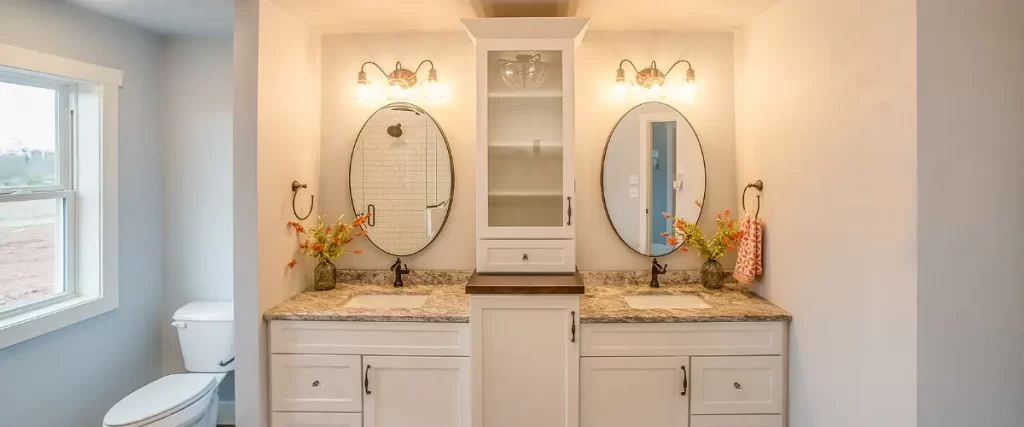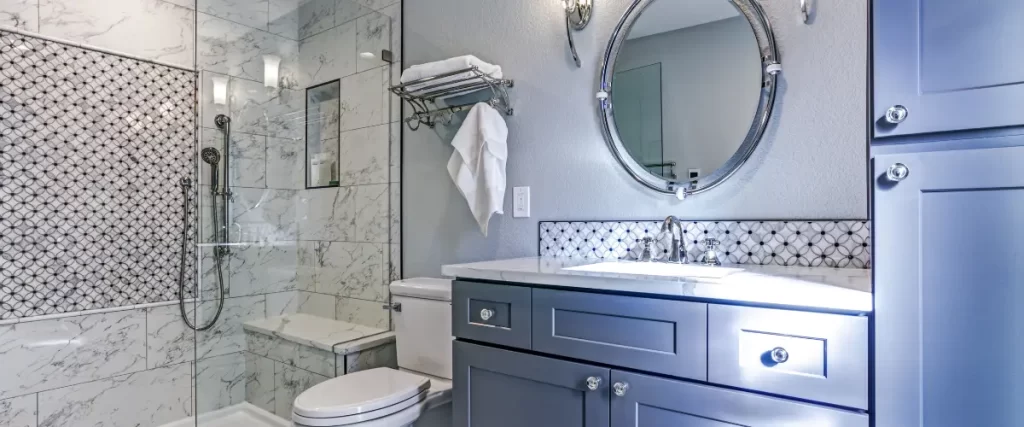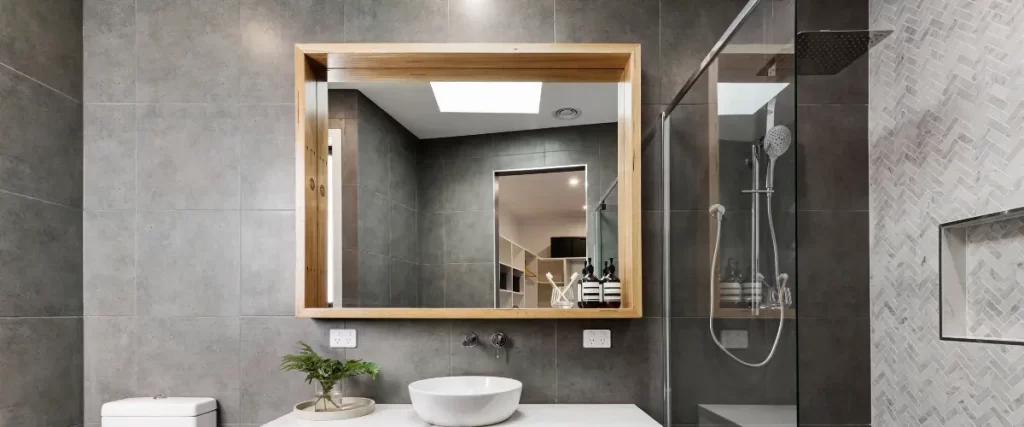Let’s talk about bathroom vanities. They’re more than just a place to stash your toothbrush—they’re the centerpiece of your bathroom. The right vanity can make your bathroom look stylish, feel practical, and even make mornings a little less hectic. But picking the perfect size? That’s where things can get tricky.
Don’t worry, though! We’re here to break it all down for you. Whether you have a tiny powder room or a big, luxurious bathroom, we’ll help you figure out exactly what size vanity you need.

Why Does Vanity Size Matter?
Vanity size is super important because it affects everything—from how much storage you’ll have to how comfortable your bathroom feels. Get a vanity that’s too big, and it might make the room feel cramped. Go too small, and you could end up without enough space for all your stuff.
The size of your vanity also affects how easy it is to move around in the bathroom. You don’t want to bump into drawers or feel squeezed when you’re brushing your teeth.
So, let’s start by looking at what measurements actually matter when choosing a vanity.
Key Measurements to Consider
- Width
- This is how wide the vanity is from one side to the other.
- Most bathroom vanities come in standard widths, starting at about 24 inches and going all the way up to 72 inches or more.
- Smaller bathrooms usually need something in the 24–36 inch range, while bigger bathrooms can handle 48–72 inches easily.
- Depth
- Depth is how far the vanity sticks out from the wall.
- Standard depths are around 20–21 inches, but some vanities are shallower—around 18 inches—to save space in smaller bathrooms.
- If you’re working with a really tight spot, there are even vanities that go as shallow as 12–15 inches.
- Height
- Vanity height is how tall it stands from the floor to the countertop.
- The standard height is 32–36 inches, but if you’re taller or shorter than average, you might want something customized.
- If you’re adding vessel sinks (the kind that sit on top of the vanity), you might need a lower vanity so the sink doesn’t end up too high.
Think About Your Bathroom Size
The size of your bathroom is the first thing to consider when picking a vanity. Here’s how to match the vanity to your space:
1. Small Bathrooms (Powder Rooms or Half Baths)
- For smaller spaces, you’ll want a vanity that’s 24–30 inches wide.
- Go with a pedestal sink or a wall-mounted vanity if you need to save even more space.
- Shallow depths (around 18 inches) work great in tight spots.
2. Medium Bathrooms
- In standard bathrooms, you can usually go up to 36–48 inches without any issues.
- This size gives you more storage and counter space without overwhelming the room.
3. Large Bathrooms (Master Baths)
- Big bathrooms can handle 60–72 inch vanities.
- If you have the room, you might even want a double vanity with two sinks for extra convenience.
- Larger vanities are great for storage, but make sure you leave enough space to move around comfortably.
Single Sink vs. Double Sink Vanities
Another big decision is whether you need one sink or two.
Single Sink Vanities:
- Great for smaller bathrooms or guest bathrooms.
- More counter space for toiletries, makeup, or decorations.
- Easier to fit into compact layouts.
Double Sink Vanities:
- Perfect for master bathrooms or shared spaces.
- Allows two people to use the vanity at the same time—no more waiting!
- Takes up more space, so you need a wider bathroom (usually 60–72 inches).
Storage Needs: How Much Space Do You Need?
Think about how much stuff you need to store. Do you just need space for a toothbrush and a hairbrush? Or do you need room for makeup, towels, and cleaning supplies?
1. Drawers and Cabinets
- Vanities with lots of drawers are perfect for keeping things organized.
- Cabinets work well for bigger items like hairdryers or extra toilet paper.
2. Open Shelving
- Open shelves can make the bathroom feel airy and modern.
- They’re great for displaying pretty baskets or rolled-up towels, but not ideal if you need to hide clutter.
3. Floating Vanities
- These are mounted on the wall and leave space underneath.
- They make small bathrooms look bigger and give you room for baskets or extra storage below.
Plumbing Considerations
Before you fall in love with a vanity, check your plumbing. Some vanities, especially wall-mounted or floating styles, might need plumbing adjustments. That can add to your costs, so it’s good to know upfront.
If you’re not sure what kind of plumbing you have, ask a plumber or contractor to take a look before you start shopping.
Material and Durability
Bathrooms get humid, so you need a vanity that can handle moisture without warping or getting damaged.
1. Solid Wood
- Strong, durable, and looks beautiful.
- Needs to be properly sealed to handle moisture.
2. MDF (Medium-Density Fiberboard)
- More affordable than solid wood.
- Works well in low-moisture areas but isn’t as durable in humid bathrooms.
3. Plywood
- A good balance between cost and durability.
- Handles moisture better than MDF.
4. Metal or Glass
- Modern and sleek.
- Easy to clean but might show water spots more easily.
Countertop Choices
Your vanity’s countertop matters, too. Here are some popular options:
1. Granite or Quartz
- Super durable and resistant to stains and scratches.
- More expensive but worth it for the long-lasting quality.
2. Marble
- Beautiful and elegant, but can stain easily if not sealed properly.
3. Laminate
- Budget-friendly and easy to clean, but not as durable as stone options.
4. Solid Surface
- Made from resin and minerals, so it’s seamless and low-maintenance.
Don’t Forget the Sink!
The sink style can also affect how much space your vanity takes up.
1. Undermount Sinks:
- Installed below the counter for a seamless look.
- Saves counter space and is easy to clean.
2. Vessel Sinks:
- Sit on top of the counter and add a modern, decorative touch.
- Require a lower vanity height to stay comfortable.
3. Integrated Sinks:
- Built directly into the countertop for a smooth, one-piece design.
- Super easy to clean and maintain.

Finding the Perfect Fit for Your Bathroom Layout
Your bathroom layout plays a big role in choosing the right vanity size. It’s not just about measurements—it’s also about how everything flows.
1. Measure Your Space
Start by measuring your bathroom. Write down the width, depth, and height of the area where you want your vanity to go. Don’t forget to leave space for doors, drawers, and cabinet doors to open.
2. Think About Traffic Flow
You need enough space to move comfortably. Make sure there’s at least 30 inches in front of the vanity for walking room. For small bathrooms, wall-mounted or corner vanities can save space and still look great.
3. Plan Around Doors and Fixtures
Check how close your vanity will be to the toilet, shower, or bathtub. You don’t want doors bumping into each other or cabinets that block access to other areas.
Matching Vanity Style to Your Bathroom Size
Once you know your measurements, it’s time to think about style. The right design can make your bathroom feel bigger, cozier, or more luxurious.
1. Wall-Mounted Vanities for Small Spaces
These vanities are perfect for tight areas because they’re mounted on the wall, leaving the floor visible. This creates the illusion of more space.
2. Freestanding Vanities for Larger Bathrooms
Freestanding vanities sit on the floor and can handle larger sinks, double sinks, or extra storage. They’re a great choice if you have plenty of space to fill.
3. Floating Vanities for a Modern Look
Floating vanities are wall-mounted but sit higher, giving the bathroom a clean, modern feel. They also leave room for storage baskets or decorative pieces underneath.
Double Vanities vs. Single Vanities: Which One Do You Need?
Still unsure if you need one sink or two? Here’s a quick guide to help you decide:
Single Vanities
- Ideal for smaller bathrooms.
- Offer more counter space if you don’t need two sinks.
- Easier to install and more budget-friendly.
Double Vanities
- Perfect for master bathrooms or shared spaces.
- Saves time during busy mornings when two people need to get ready.
- Requires a wider layout (usually 60–72 inches).
Vanities for Different Bathroom Types
1. Powder Rooms
Powder rooms are usually smaller and don’t need a lot of storage. Go for a compact vanity—24–30 inches wide is plenty. Pedestal sinks or wall-mounted options also work great in these spaces.
2. Guest Bathrooms
Guest bathrooms need to be functional but not over-the-top. A 36–48 inch vanity with enough storage for essentials is a good pick.
3. Master Bathrooms
Master bathrooms are often larger and more luxurious, so this is where double vanities shine. You can go big—60–72 inches—and include plenty of storage, countertop space, and extra features like makeup stations.
Final Touches: Mirrors, Lighting, and Accessories
Choosing the right vanity is just the first step. The finishing touches make a huge difference.
1. Mirrors
- Match the mirror size to the vanity width for balance.
- Frameless mirrors give a modern look, while framed mirrors add character.
2. Lighting
- Install lights above or beside the mirror for even lighting.
- Sconces or pendant lights create a cozy feel, while LEDs add brightness.
3. Hardware and Faucets
- Choose handles, knobs, and faucets that match your vanity style.
- Brushed nickel, matte black, or gold finishes are popular choices.

FAQ: Choosing the Right Vanity Size
1. What size vanity is best for a small bathroom?
A 24–30 inch vanity works well in smaller bathrooms. Wall-mounted or corner vanities are also great space-saving options.
2. Can I put a double vanity in a small bathroom?
It depends on the layout. You’ll need at least 60 inches of space for a double vanity, so it’s better for medium or large bathrooms.
3. What’s the most common vanity height?
Standard vanity height is 32–36 inches, but you can adjust this based on your needs, especially if you’re adding vessel sinks.
4. Do I need extra plumbing for a double vanity?
Yes, double vanities usually require additional plumbing, which can increase costs. Be sure to check this before deciding.
5. How much storage should a vanity have?
It depends on what you need to store. If you have lots of products and towels, look for vanities with drawers, cabinets, or shelves.
Make Your Bathroom Shine with the Perfect Vanity
Choosing the right vanity size isn’t just about measurements—it’s about creating a space that feels functional, stylish, and organized. Whether you need a small vanity for a powder room or a double vanity for a master bathroom, taking the time to find the perfect fit can completely transform your bathroom.
At Rise Up Renovations, we’re here to help you make your dream bathroom a reality. From modern designs to timeless classics, we’ll help you find the right vanity that fits your space and style perfectly. Ready to upgrade your bathroom? Contact us today at (816) 200-7741 to start your project!
